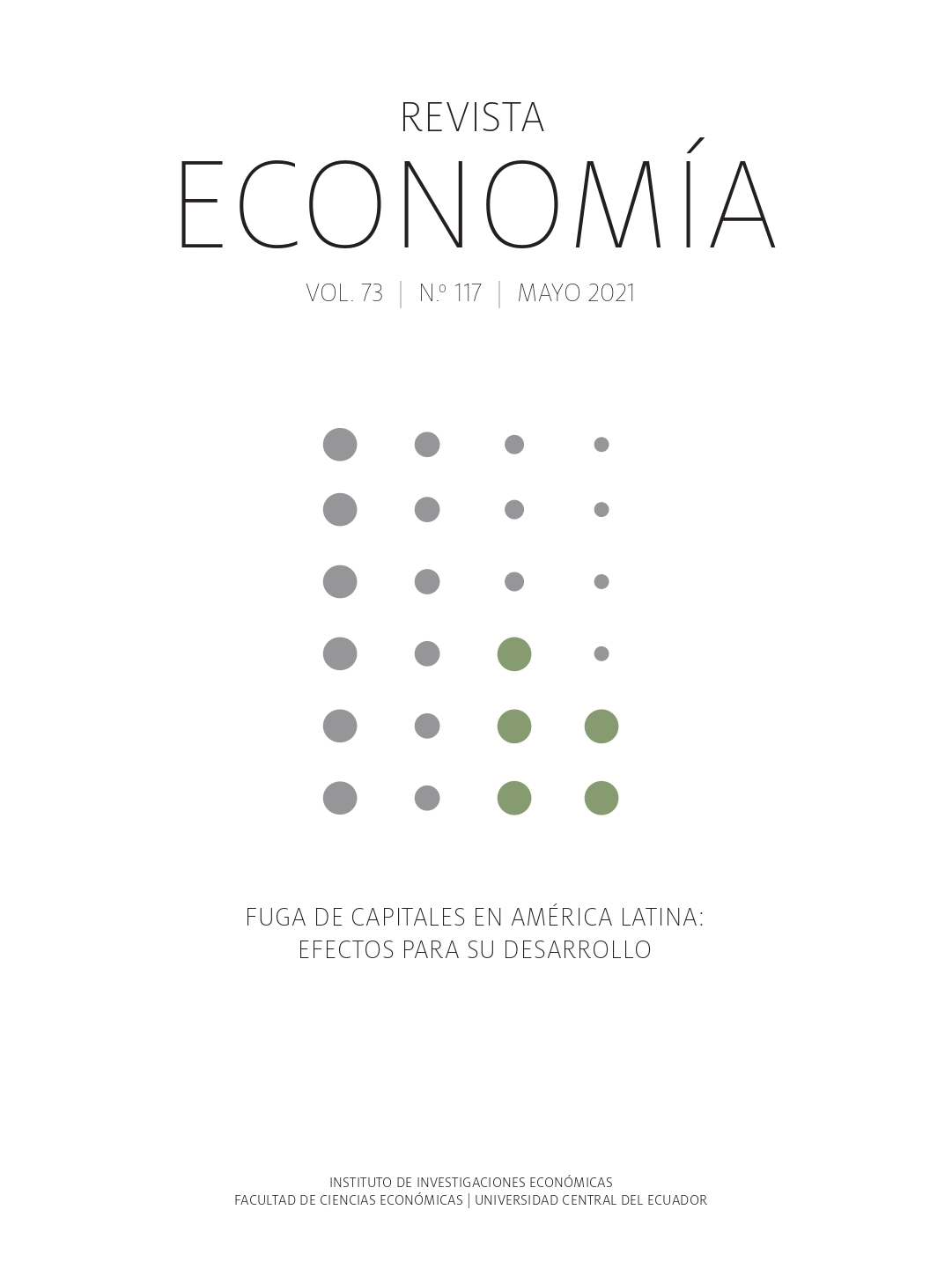Concentración y tasas de Interés en el sistema financiero ecuatoriano
Contenido principal del artículo
Resumen
El paradigma neoclásico de la competencia impone en los mercados un modelo basado en la desregulación para conseguir el desarrollo que es definido como el mercado desregulado, en la práctica, esto solo provoca una mayor concentración. Con el objetivo de constatar los niveles de concentración en el sistema financiero ecuatoriano y sus consecuencias, se plantea un análisis de los indicadores de organización industrial y de las tasas de interés, considerando también la teoría de la competencia.
Descargas
Detalles del artículo

Esta obra está bajo una licencia internacional Creative Commons Atribución-NoComercial 4.0.
Los autores que publiquen en esta revista aceptan las siguientes condiciones:
- Los autores mantienen los derechos de autor y ceden a la Revista Economía el derecho de la primera publicación, con el trabajo inscrito bajo Creative Commons Reconocimiento-NoComercial 4.0, que posibilita a terceros la redistribución, comercial o no comercial, de lo publicado siempre y cuando el artículo circule de manera completa y sin cambios.
- Los autores pueden efectuar otros pactos contractuales independientes y adicionales para la distribución del artículo publicado en esta revista (por ejemplo, añadirlo en un repositorio institucional o publicarlo en un libro) siempre y cuando especifiquen de forma clara y evidente que el artículo se publicó por primera vez en la Revista Economía. En caso de reproducción deberá constar una nota similar a la que se presenta a continuación: Este texto se publicó originalmente en la Revista Economía N.º…, volumen…, número de páginas, año de publicación.
- Se sugiere a los autores publicar su trabajo en internet (por ejemplo, en páginas institucionales o personales) de la versión final publicada por la Revista Economía, puesto que esto puede conducir a una difusión mayor y más rápida del artículo publicado.
Citas
Asobanca. (2019). Informe Técnico: Tasas de interés. Publicaciones Asociación de Bancos del Ecuador.
Beck, T. (2008). Bank competition and Financial stability: Friends or Foes? Policy Research working paper.
Camino, S., Uzcátegui, C. y Moran, J. (2017). Estructura de mercado del sistema bancario ecuatoriano:
concentración y poder de mercado. Cumbres, 09-16.
Casu, B. and Girardone, C. (2006). Bank Competition, Concentration and Efficiency in the Single
European Market. Manchester School, 441-468.
Cetorelli, N. (2006). Real effects of Bank competition. The Ohio State University Press, 543-558.
DeYoung, R. and Rice, T. (2004). Noninterest income and financial performance at US commercial banks.
Financial Review, 101-127.
Durand, F. (2020). El debate sobre la captura del Estado en América Latina y la vuelta del instrumentalismo,
con referencia especial a Perú. En Concentración económica y poder político en América
Latina (pp. 44-92). Buenos Aires.
Hernández, I. (2010). Tributación y desarrollo en perspectiva. Revista de economía institucional, 13-24.
Jaramillo, O. y Ramírez, R. (2020). Concentración y dinámica empresarial: Estudio estructural de la
economía ecuatoriana. Repositorio Universidad Central del Ecuador, Facultad de Ciencias
Económicas.
King, R. and Levine, R. (1993). Finance, entrepreneurship and growth. Theory and evidence. Journal of
Monetary Economics, 513-542.
Levine, R. (1997). Financial development and economic growth: views and agenda. Journal of money, credit
and banking, 596-613.
Marichal, C. y Gambi, T. (2017). Historia bancaria y monetaria de América Latina (siglos XIX y XX).
Editorial de la Universidad de Cantabria.
Marx, K. (1978). Capital. Crítica de la Economía Política.
Minsky, H. (2008). Stabilizing an unstable economy. McGraw Hill.
Miño Grijalva, W. (2008). Breve Historia Bancaria del Ecuador. Corporación Editora Nacional.
Morandé, F. (2016). A casi tres décadas del Consenso de Washington ¿Cuál es su legado en América Latina?
(s. d.).
Pepall, L., Richards, D. and Norman, G. (2014). Industrial organization contemporary theory and empirical
applications (5th ed.). Wiley.
Pozo, S. (2018). Competencia y estabilidad en el sistema bancario: Evidencia empírica para el Ecuador
durante el periodo 2001-2016. Universidad de Cuenca .
Regalado, P. y Espinoza, V. (2018). Desarrollo financiero en Ecuador: Análisis de la concentración del sector
cooperativo de ahorro y crédito del Segmento 1. x-Pedientes económicos, 20-36.
Rochet, J.-C. and Freixas, X. (1999). Microeconomics of Banking. MIT Press.
Schumpeter, J. (1997). Teoría del desenvolmiento económico. Fondo de Cultura Económica.
Vera, C. y Titelman, D. (2013). El sistema financiero en América Latina y el Caribe. Naciones Unidas.
Vera-Gilces, P., Camino-Mogro, S., Ordeñana-Rodríguez, X. and Cornejo-Marcos, G. (2019). A look inside
banking profitability: Evidence from a dollarized emerging country. The Quarterly Review
of Economics and Finance. (s. d.).
Weeks, J. (2009). Teoría de la competencia en los neoclásico y en Marx. MAIA Ediciones.

